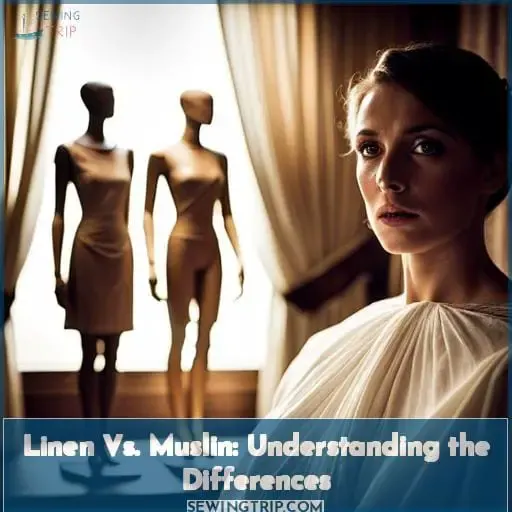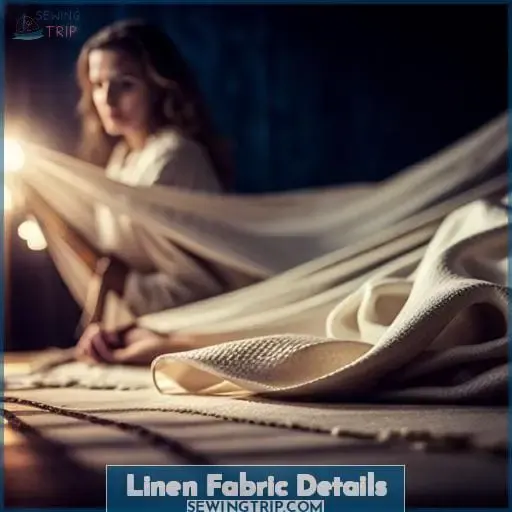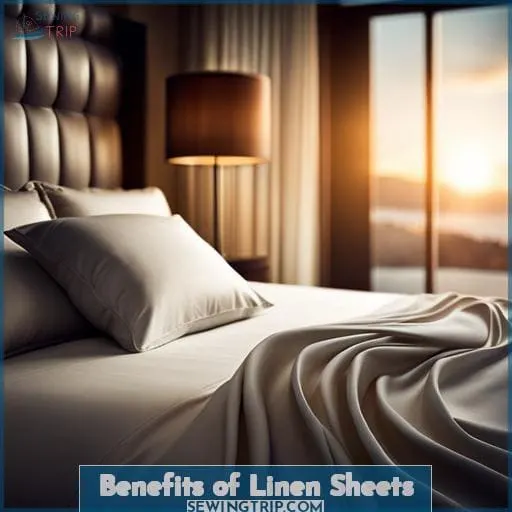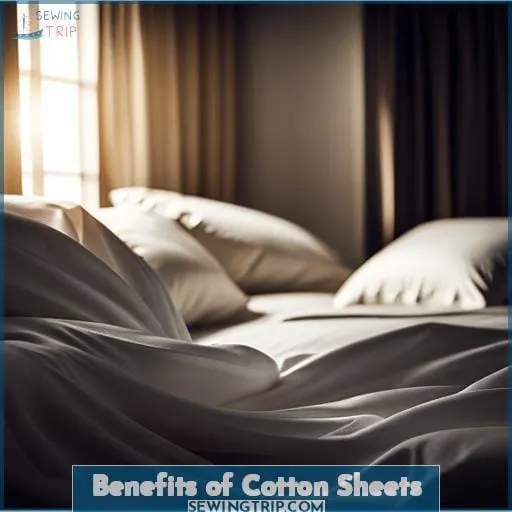This site is supported by our readers. We may earn a commission, at no cost to you, if you purchase through links.
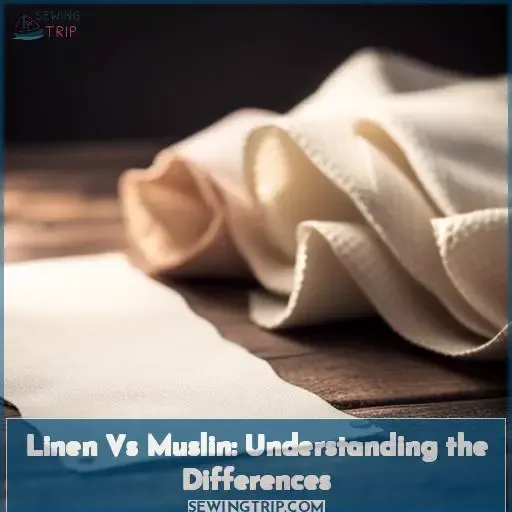 Do you want to understand the differences between linen and muslin? Both of these fabrics can be used for a variety of projects, yet they have several distinct qualities. Linen is made from flax fibers while muslin is made from cotton. Each fabric has its own advantages and disadvantages when it comes to texture, durability, strength and cost that make them ideal for certain applications over others.
Do you want to understand the differences between linen and muslin? Both of these fabrics can be used for a variety of projects, yet they have several distinct qualities. Linen is made from flax fibers while muslin is made from cotton. Each fabric has its own advantages and disadvantages when it comes to texture, durability, strength and cost that make them ideal for certain applications over others.
Linen is produced from the fibers of the flax plant and known for its exceptional strength and durability. This fabric has a crisp, textured feel and a natural luster that becomes softer over time. It’s very breathable, absorbent and resists pilling. However, linen can wrinkle easily.
It’s a heavier weight fabric that drapes nicely and is ideal for items like pants, jackets, dresses, skirts, bags and home décor.
Muslin is a lighter weight, plain cotton fabric made from carded cotton yarns. It has a soft, smooth texture and is very inexpensive and easy to work with. Muslin is weaker than linen, but it’s ideal for mockups, test garments, curtains, backdrop material and quilting.
It can fray easily if not treated. While not as durable for frequent wear, muslin works well for inexpensive everyday garments.
When choosing between linen and muslin, consider factors like the draping, structure, durability and cost you want for your particular project. Both natural fabrics have their own characteristic beauty and benefits for sewing and home goods.
Identify how you intend to use the fabric to pick the better option for your specific needs.
Table Of Contents
Key Takeaways
- Linen is made from flax fibers and known for its strength, durability, and natural luster.
- Muslin is made from cotton and is lighter in weight, inexpensive, and easy to work with.
- Linen is ideal for pants, jackets, dresses, skirts, and home decor, while muslin is versatile for clothing and upholstery.
- Both linen and muslin have their advantages, so factors like draping, structure, durability, and cost should be considered when choosing between the two fabrics.
Linen Vs. Muslin: Understanding the Differences
As textile engineers, we’ll dive right in and explore the key distinctions between linen and muslin fabric. From breathability and durability to everyday uses and proper care, we’ll compare linen versus muslin across the essential characteristics you need to know when selecting the right natural fibers for your projects and designs.
The open weave of linen makes it a highly breathable fabric, while muslin’s more tightly woven threads create a lighter feel. Linen’s natural fibers lend a cool, crisp hand, and it resists pilling very well over time.
Muslin has a softer drape and forms to the body more easily. It can withstand high heat when ironing or steaming. For clothing, linen works well in warmer weather, resisting humidity and retaining color beautifully.
Muslin offers a versatile base for clothing, upholstery, and more. At the end of the day, both natural fabrics have their advantages. Choose linen when breathability and color retention matter most, like in a summer dress or lightweight pants, While muslin’s affordability and easy care make it ideal for mockups, bedding, curtains, and everyday crafts.
With proper washing and drying methods, both fabrics can provide lasting beauty and comfort.
Fabric Characteristics
You’ll find linen somewhat coarse but softening after washing, while muslin has a soft and smooth texture; both fabrics offer good breathability and are durable, with linen being slightly stronger. As a sewing instructor, I recommend learning about the unique textures and weaving styles of linen and muslin.
Consider breathability, wrinkle resistance, manufacturing processes, and cost when selecting the ideal natural fabric for your project’s design and purpose.
Practical Uses
While muslin’s softness makes it ideal for gentle items like baby blankets, cloth can be useful for numerous projects.
- Embroidery Styles – Muslin offers a wide variety of styles for embroidery.
- Rustic Decor – Linen is great for creating a rustic or elegant look in home decor.
- Linen Upholstery – Depending on its weight, linen has multiple upholstery uses.
- Muslin Backdrops – Muslin is often used for backdrops and quilting.
Care and Maintenance
Caring for and maintaining your favorite natural fabrics doesn’t have to be tricky.
Wash both linen and muslin in cold water using a gentle detergent or delicate cycle. Hang dry or dry them flat after washing. Iron them with a medium heat and spray with water first to prevent scorching.
Here are some other fabric care tips:
| Fabric | Washing | Drying | Ironing | Other Tips |
|---|---|---|---|---|
| Linen | Cold water, delicate cycle | Hang dry or dry flat | Medium heat, spray with water first | Avoid bleach |
| Muslin | Cold water, delicate cycle | Hang dry or dry flat | Medium heat | Wash before first use to preshrink |
Treat stains ASAP and air dry fabrics for longevity. Simple care keeps natural fabrics looking their best.
Muslin Fabric Details
Looking to incorporate muslin into your next cotton project? This breathable fabric comes in four main types including gauze, Swiss, mull, and sheeting for uses like backdrops, quilting, and clothing. Compared to linen, muslin has a softer hand but less durability and can be manufactured in an eco-friendly way with organic cotton and natural dyes.
Muslin is a lightweight cotton fabric that has many uses. The four main types – gauze, Swiss, mull, and sheeting – each have their own unique characteristics that make them suitable for different applications.
Muslin is valued for its breathability and softness. It tends to be less durable than linen, but lends itself well to eco-friendly production methods using organic cotton and natural dyes. Quilters, clothing designers, backdrop artists, and crafters all find uses for the versatile muslin fabric.
Types of Muslin
Despite its lighter weight, muslin dazzles with versatility through its four main types – gauze, Swiss, mull, and sheeting – each bringing distinct qualities that make this fabric a crafter’s dream.
- Gauze muslin: The open weave provides sheerness and breathability.
- Swiss muslin: The finer weave creates smoothness and durability.
- Mull muslin: When bleached and stiffened, it is often used for embroidery.
- Sheeting muslin: It is the most widely used type for quilting and apparel.
The range of muslin types empowers crafters to choose the perfect lightweight natural fiber fabric for any project.
Muslin Vs. Linen Comparison
Muslin’s softness contrasts linen’s roughness, though both fabrics breathe wonderfully.
The unique textures and breathability of linen and muslin fabrics cater to different needs. Though both natural fibers bring quality to sewn goods, key differences in weave tightness significantly impact the softness, durability, and versatility of each historic textile.
Linen’s looser weave gives it a rougher texture that’s more durable for frequent laundering and embroidery. Muslin’s tighter weave produces a smooth, lightweight, hypoallergenic feel that’s ideal for detailed embroidery in warm climates.
Versatility and Eco-Friendly Options
Slip into the soft versatility of environmentally-conscious muslin for your most creative DIY projects ever. Opt for muslin over linen due to its ecological benefits: organic materials, natural dyes, water conservation.
From lightweight sheets to medium-weight embroidery backings, sustainable muslin provides versatile applications from the versatile cotton plant.
Linen Fabric Details
Dear sewist, are you considering linen for your next project? Linen and cotton have quite different properties. The rough, dry texture of linen contrasts with cotton’s smoother feel. However, linen’s looser weave makes it more breathable and ideal for those with allergies.
Linen Vs. Cotton Comparison
You’ll feel the cool, crisp breathability of linen against your skin as you drift off to sleep on summer nights. Cotton’s softness cannot compete with linen’s superior breathability. Linen’s looser weave and lower thread count prevent allergens from becoming trapped.
The natural fibers efficiently wick moisture, keeping you more dry and comfortable. Choose linen over cotton for ultimate temperature regulation and fewer night sweats.
Texture and Breathability
Though linen’s tighter weave makes it rougher than muslin’s smooth softness, you’ll love how its breathability keeps you cooler. An artisan mindful of textural contrast may layer linen and muslin for dimensional depth in a summer dress.
Like breath on skin, the lightweight weave of these natural fibers liberates you from the oppression of synthetic fabrics.
Linen and muslin both invite free air circulation with their open construction, but compare fabric feel to find your ideal match. Choose linen for its cooling properties, or muslin for its softness against sleep-warmed skin.
Considerations for Allergies
You can clasp cotton’s smoother appeal for cooler comfort if allergies arise.
- Choose hypoallergenic fabrics.
- Avoid irritants like lanolin.
- Opt for tightly woven textiles.
Cotton’s smooth surface prevents allergens from clinging while still allowing airflow.
Benefits of Linen Sheets
As a textile engineer, I frequently hear this question. Linen sheets truly excel due to their cooling and moisture-wicking capabilities, providing breathable comfort for sleeping.
Cooling and Moisture-Wicking Properties
The fibers’ unruly texture whisks moisture from the skin, leaving you dry and cool. Linen’s hollow fiber structure absorbs moisture and then releases it quickly. This natural wicking action keeps sleepers dry, preventing sticky discomfort.
Linen’s breathability circulates air, regulating body temperature for restful sleep.
| Feature | Linen | Cotton |
|---|---|---|
| Moisture Wicking | Excellent | Good |
| Breathability | Excellent | Good |
| Temperature Regulation | Excellent | Good |
Linen’s superior moisture control and cooling properties make it an ideal choice for quality bedding.
Breathability for a Comfortable Sleep
Friend, linen sheets are an excellent choice for sleeping comfortably on hot nights. The natural fibers of linen have a loose, breathable weave that allows air to circulate freely. This quality makes linen bedding uniquely effective at regulating body temperature and wicking away moisture as you sleep.
Unlike cotton or synthetic sheets, linen optimizes airflow and humidity control. Its lightweight, breezy structure creates a relaxing environment for restful slumber. Compared to other fabrics, linen is unmatched in its natural ventilation and breathability.
Its relaxed, easygoing style brings a lightness that helps you sleep peacefully through the night. For cooler, comfier sleep on humid nights, linen sheets are a chill, breathable option.
Durability and Longevity
I guarantee linen’s sturdiness holds up well for the long term. From its natural fiber strength to its resilient weave, linen withstands wear and tear. This long-lasting fabric choice remains your loyal companion through years of use.
Linen’s unparalleled material resilience outlives other fabrics, promising a longer lifespan for you.
Benefits of Cotton Sheets
Cotton sheets offer unparalleled softness and smoothness against your skin. Suitable for all seasons, cotton’s breathability keeps you cool in summer yet cozy in winter. The natural fibers allow airflow to regulate temperature. Cotton’s ability to absorb moisture pulls perspiration away from your body, leaving you dry and comfortable.
Easy to wash and durable, high-quality cotton bedding will become softer over time. Choose single-ply with a high thread count for lightweight sheets ideal for hot sleepers. Opt for double-ply cotton in colder months to retain warmth without overheating.
With proper care, cotton sheets last for years, giving you a beautiful bed for less cost over time compared to other materials.
Smoothness and Softness
Your skin will practically sigh in pleasure as cotton’s silky-smooth embrace caresses you through the night. Cotton’s soft fibers caress your skin with a whisper-light touch, enveloping you in cloud-like comfort.
The smooth surface glides against you, soothing your senses. Cotton’s tactile qualities evoke blissful tranquility. Its feather-soft fibers tenderly stroke your skin, lulling your mind with each delicate brush.
Cotton’s exquisite texture surrounds you in serene satisfaction. Like a gentle lover, cotton sheets’ delicate softness delights your senses.
Suitable for All Seasons
Use cotton sheets in all seasons because they’re breathable yet cozy. The versatility of cotton enables comfortable sleeping no matter the climate. In summer, cotton’s breathability keeps you cool while its smooth weave prevents sticking.
When temperatures drop, layer blankets over cotton sheets for cozy warmth. Cotton’s superior temperature regulation delivers all-year comfort.
Recommendations for Choosing the Right Fabric
When selecting fabric for your next project, it’s essential to consider the characteristics and ideal uses for linen versus muslin. To find the perfect match for your needs, do your due diligence on the differences, and don’t forget to factor in the intended application, required care, and personal preferences before making a final decision between these timeless natural fabrics.
Researching the unique properties and best uses for linen and muslin is key when deciding between the two for an upcoming sewing project or craft. Compare their breathability, durability, ease of care, and cost to determine which is better suited to your plans.
Weigh your priorities like project type, maintenance, and budget before settling on linen or muslin as you shop for material. With some diligent comparison shopping, you’ll choose the ideal fabric for your next creation.
High-Quality Brands and Suppliers
Finding peace in your bedroom begins with trusting top suppliers like American Blossom Linens for their dedication to quality. Renowned for luxurious linens, cotton comfort, and sustainable choices, this brand provides discerning buyers with the ultimate fabric selection for bedding.
Pairing linens from reputable brands with the ideal mattress establishes an oasis for restful slumber. Carefully selecting suppliers such as American Blossom Linens guarantees access to premium bedding for years ahead.
Factors to Consider for Better Sleep Experience
When choosing sheets, let’s focus on what really matters: the factors that lead to a peaceful night’s rest versus a restless one. Make sleep hygiene and restful slumber your top priorities. Opt for breathable, temperature-regulating bedding that complements your mattress and sleep environment.
Make going to bed a ritual: establish pre-bed routines, limit blue light exposure, keep your bedroom cool and quiet. With thoughtful choices that enhance your sleep, you’ll wake up refreshed, energized, and ready to seize each new day.
Conclusion
Linen vs. muslin: key differences
Linen and muslin are two of the most unique fabrics around. Both offer breathability, durability and versatility for fashion, decor and crafts.
Muslin is softer and more lightweight. It’s great for embroidery, curtains and quilting. Linen is stronger and more textured. It excels for clothing, home decor and bedding.
Both fabrics require pre-shrinking and cold washes to maintain quality. With the right pick, you can achieve an elegant linen look for decor or a lightweight muslin feel for a blanket.
So choose thoughtfully and enjoy the difference! Linen and muslin each shine in their own way.

